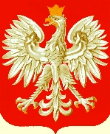Vital Records - Extracts
You will often come across extracts of vital records.
The extract is not the original record kept by the priest in the parish
registers of births, marriages, and deaths, but rather an official copy based on
the information found in the parish register.
The forms of the extracts come in all shapes and sizes
depending on the time period, country of issue, and person creating the
document.
Here are some typical examples of extracts you may come
across. Certainly, the translations will still help you decipher a
document even if the document is in a slightly different format.
Certificate of Baptism
Popular format from Eastern Galicia/Western Ukraine
including Ukrainian and Latin. Often our ancestors brought over, or later
sent for, this important document. The forms were usually in Latin or in
both Latin and Ukrainian. As was customary in the church registers, the
first names of the people were usually in Latin while the last names were
spelled in Polish, or using Polish phonetics.
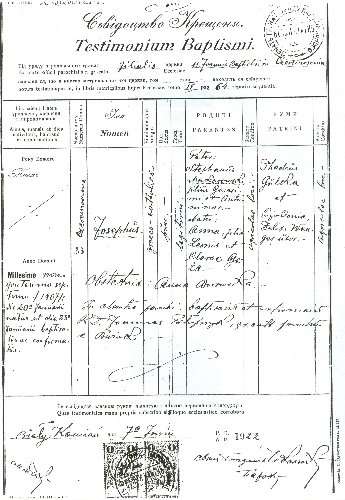 |
Certificate of baptism
On the part of the Greek Catholic chapel of the
church of St. John the Baptist in Czeremosznia
it is announced that in the registry books of this church, volume IV,
page 64 is found the following:
Year, month and day
of birth, baptism and confirmation |
House
number |
Name |
Religion |
Sex |
Status |
Parents |
Occupation |
Godparents |
Occupation |
Year of our Lord
one thousand nine hundred seven/1907/ the 20th day of January
born and the 23 day of January baptized and confirmed. |
Czerem-
osznia, 23 |
Iosyf
(in Ukr.) |
Greek Catholic |
boy |
legiti-mate |
Father:
Stefan Makarowski, son of Herasym and Antonina.
Mother:
Anna, daughter of Leon and Klara Geża |
local farmers |
Tadeusz Gulka and Apolonia
Wenger, wife of Feliks |
local farmers |
| |
Midwife: Anna
Borowska |
| |
In the absence of
the parish priest baptized and confirmed by Rev. Ivan Polosnyk,
Greek Catholic priest from Bużek |
This certificate I sign with my own hand and certify with
the church's seal.
Biały Kamień, day 7th of June, A.D. 1922
|
Another example of a Certificate of Baptism
Another example of this common format. At the top
of this example is the geographic information for both the church and the
government jurisdictions. Of course, this is critical to finding one's own
ancestral parish and village.
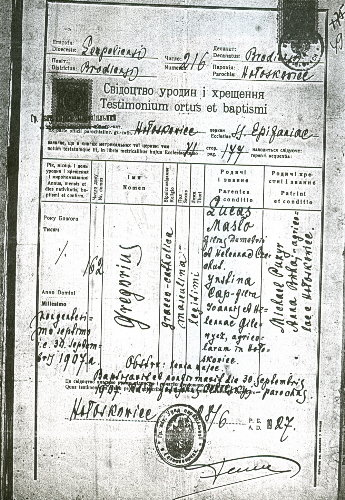 |
Diocese: Leopoliensis (Latin for
Lwów, Львів /
Lviv)
Deanery: Brodiensis (Latin for Броди /
Brody)
County: Brodiensis (Latin for Броди /
Brody)
Parish: Hołoskowice (in Ukr.
Голосковичі / Holoskovzchi)
Certificate of Birth and Baptism
On the part of the Greek Catholic parish
Hołoskowice
church St. Epifania
it is announced that in the registry books of this church, volume VI,
page 177 is found the following:
Year, month and day
of birth, baptism and confirmation |
House
number |
Name |
Religion |
Sex |
Status |
Parents and Occupations |
Godparents and Occupations |
Year of our Lord
one thousand nine hundred seven/1907/ the 30 day of September
1907. |
162 |
Hryhoryi
(in Ukr.) |
Greek Catholic |
masculine |
legitimate |
Luka Masła,
sone of Dmytro and Helena Czechut.
Iustyna Cap, daughter of Ivan and Helena Gilenycz, farmers in
Hołoskowice. |
Mykhailo Puzyr
Anna Oohaj
farmers from Hołoskowice |
| |
Midwife: Ksenia
Kujec |
| |
Baptized and
confirmed on the 30th of September 1907. Rev. Iosyf ?,
parish priest. |
| |
Hołoskowice, 28/6 <June>, 1927. |
This certificate I sign with my own hand and certify with
the church's seal. |
Certificate of Baptism
(contemporary Polish Roman Catholic Church extract)
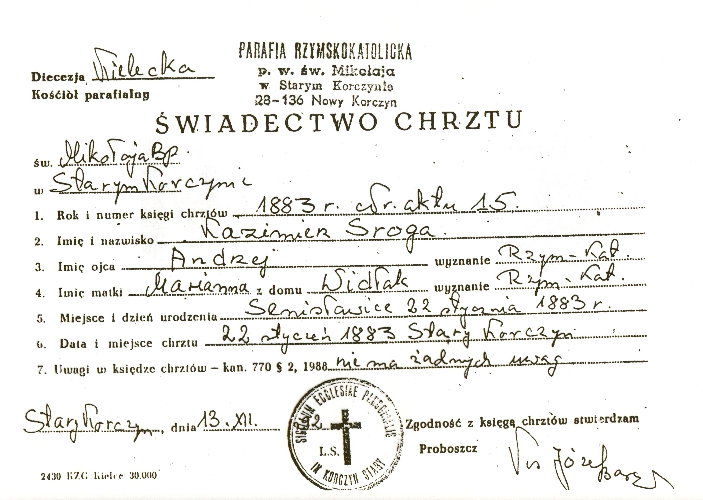 |
Diocese: Kielce
Parish Roman Catholic Church
<Stamp reads:> Roman Catholic Parish
Saint Nicholas (Sw. Mikołaj)
in Stary Korczyn
28-126 Nowy Korczyn
Certificate of Baptism
St: Mikołaj
in: Stary Korczyn
1. Year and Number of Baptismal Register/Book: 1883
Roman Catholic Record #15
2. Given name and surname: Kazimierz Sroga
3. Name of father: Andrzej
Religion: Roman Catholic
4. Name of mother: Marianna Maiden
name:
Widłak
Religion: Roman Catholic
5. Place and day of birth: Senisławice
22 January 1883 year.
6. Date and place of baptism: 22-January-1883 Stary
Karczyn
7. Notes in baptismal register/book: there are no notes
Stary Korczyn,
day 13-December. I affirm conformity with
the baptismal book
|
Extract from a Polish state
Office of Vital Records
(Urząd Stanu Cywilnego, commonly abbreviated USC)
According to Polish regulations, older
records are delivered from local churches to local town record halls, known in
Polish as Urząd Stanu Cywilnego, which is commonly
abbreviated USC. These record offices are found in larger towns
which support all of the local neighboring villages. Usually when you request
records from these record offices, you will get a typed or hand-written extract.
Unfortunately, all of the detail that is found in the original parish record may
not be copied over to the extract. The clerk simply fills in the
appropriate lines on the form and unknowingly leaves out potentially critical
information to a genealogist.
Important note regarding territory that was
once in Poland before WWII but not in Poland after WWII: After World War
II the borders of Poland and the USSR were changed. The Polish border
actually moved about 200 kilometers to the west. Therefore, a considerable
amount of territory which was in Poland before WWII all of a sudden found itself
inside the USSR. Often, Roman Catholic records from this area of Poland
were moved to a USC in Downtown Warsaw. This collection of records is
often referred to as the Zabużański
Collection as the term "zabużański" means "beyond the
Bug River", which is roughly the new eastern border between Poland and what was
the USSR (today, the border would be between Poland and its three eastern
neighbors Lithuania, Belarus and Ukraine).
This example comes from the USC in Downtown
Warsaw, also known as the "Zabużański Collection".
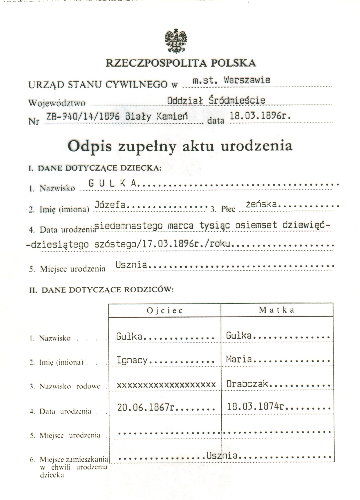 |
Republic of Poland
Office of Vital Records in
Old Town Warsaw
Province
Downtown Office
Nr. ZB <back side>-940/14/1896
<parish>
Bialy Kamien, date 18-March-1896
Complete Transcript of Birth
Record
Data concerning child
1. Surname: GULKA
2. Given name: Jozefa
3. Gender: Female
4. Date of birth: seventeenth of March one thousand eight
hundred
ninety-six (17.3.1896 year)
5. Place of birth: Usznia
Data concerning parents
Father
Mother
1. Surname Gulka
Gulka
2. Given name Ignacy
Maria
3. Maiden name ********
Drabczak
4. Date of birth 20-June-1867
18-March-1874
5. Place of birth <blank>
<blank>
6. Place of residence at time of child's birth
Usznia
|
Extract of Birth Record
inter-war period
Form written in Polish since at the time the region was a
part of the Poland. Often the information filled in is in Polish, Latin
(most likely copied directly from the original church record in Latin) or
Ukrainian and/or Ukrainianized Polish.
In this example below, notice the first names are written
in Latin (Michael and Basilius, which would correspond to Михайло/Mykhailo
and Василь/Vasyl in Ukrainian.)
Also note that the author of the extract used Polish
spellings of place names. However, since the official language of the
Polish Republic was Polish, this is not unexpected. Here are the
corresponding languages' spellings for the geographic areas mentioned:
| Polish |
Ukrainian (transliterated) |
Ukrainian (proper Cyrillic) |
| Tarnopol |
Ternopil' |
Тернопіль |
| Przemyślany |
Peremyshliany |
Перемишляни |
| Wołków |
Vovkiv |
Вовків |
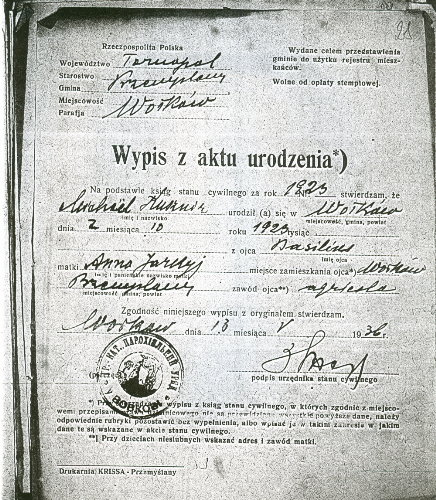 |
Republic of Poland
Issued for the purpose of showing to the sub-district
Province: Tarnopol
for the use of registering residents.
Jurisdiction: Przemyślany
Free of charge
Sub-district: Przemyślany
Place: Wołków
Parish: Wołków
Extract of a birth
record
On the basis of the
civil registries for the year 1923
I affirm, that
Michael (Mykhailo in Ukrainian)
Kuszniz born in Wołków
on the 2nd day of 10th month
in the year 1923
of father Basilius (in Latin.
This is Vasyl in Ukrainian)
and mother Anna Jarkyj . Place of residence
of the father Wołków,
Przemyślany (district). Occupation of father**
agricola (Latin for "farmer").
I confirm the agreement of this extract with the original.
Wołków day 18th
month V (5 or May) 1936.
Signature of civil registrar
*With the drawing up of the extract
from the civil registry, in agreement with the local regulations of the
regional district law, some of the above information is not specified,
you should leave appropriate fields blank or write them down in such a
way in which the information is pointed out in the record.
**For children of unmarried parents indicate address and occupation of
mother.
|
Certificate of Marriage
Popular format from Eastern Galicia/Western Ukraine
including Ukrainian and Latin. Often our ancestors brought over or later
sent for this important document. Often the forms were just in Latin or in
both Latin and Ukrainian. As was customary in the church registers, the
first names of the people were usually in Latin while the last names were
spelled in Polish, or using Polish phonetics.
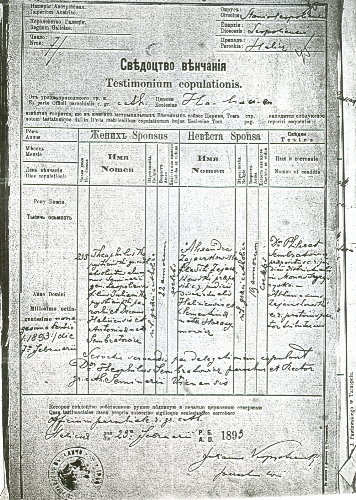 |
Empire of Austria
Circle (District): (Pol.) Stanisławów.
(Ukr.)
Станіславів / Stanislaviv
Crownland of Galicia
Diocese: (Pol.) Lwów. (Ukr.)
Львів / Lviv
Number: 71
Parish: (Pol.) Halicz. (Ukr.) Галич /
Halych
Certificate of marriage
On the part of the parish of the
Greek Catholic Chruch of (Pol.) Halicz. (Ukr.)
Галич / Halych
it is announced that in the registry books of marriages of this church,
volume __, page __ is found the following:
| Year |
Groom |
Bride |
| Month |
House No. |
Name |
Religion |
Age |
Single or Widower |
Name |
Religion |
Age |
Single or Widow |
Witnesses
Name and Occupations |
Year of our Lord
one thousand eight hundred 1893, the 7th of February |
235 |
Teofil Kopystianski, Greek Catholic alum of the
Seminary in Leopolis (Lwów, Lviv), son of
Iulian Kopystianski priest and deacon of Halicz/Halych and
Antonina nee Sebratowicz |
Greek Catholic |
22 years old |
single |
Aleksandra Zajaczkowska, daughter of Filon
Zajaczkowski, baillif of the judicial district of Halicz/Halych
and Klementyna nee Harasymowicz |
Greek Catholic |
19 years old |
single |
Filaret Sembratowicz, baillif of the judicial
district of Monasterzyska.
Atanazy Zajaczkowski, baillif o |
| |
|
This certificate I sign with my own hand and certify with
the church's seal.
|
Extract of Marriage Record
inter-war period
Form written in Polish since at the time the region was a
part of the Poland. Often the information filled in is in Polish, Latin
(most likely copied directly from the original church record in Latin) or
Ukrainian and/or Ukrainianized Polish.
Interesting note on language and first names. In
this example below, notice that some first names seem to be written in Ukrainian
using Polish spelling (Stefan, Sofja). These are spelled in Ukrainian
Стефан / Stefan and Софія / Sofia.
While some other names are written in Polish (Franciszek <listed here in
genitive form Franciszka, or "of Franciszek">, and Katarzyna <listed here in
genitive form Katarzyny, or "of Katarzyna">. These would correspond in
Ukrainian to Франко / Franko and Катерина
/ Kateryna. However, this could be the result of a confused bilingual
clerk, a clerical error/confusion or might even be a legitimate reason, such as
Franciszek was an ethnic Pole who went by the name Franciszek and not the
Ukrainian equivalent Franko (which is impossible to tell without looking at the
original record and knowing the ethnicity and or "preference" of the people
involved.
Also note that the author of the extract used Polish
spellings of place names. However, since the official language of the
Polish Republic was Polish, this is not unexpected. Here are the
corresponding languages:
| Polish |
Ukrainian (transliterated) |
Ukrainian (proper Cyrillic) |
| Tarnopol |
Ternopil' |
Тернопіль |
| Przemyślany |
Peremyshliany |
Перемишляни |
| Uszkowice |
Ushkovychi |
Ушковичі |
| Czupernosów |
Chupernosiv |
Чуперносів |
All of this is a perfect example of the
unique multilingual, multicultural society of Eastern Galicia/Halychyna.
Notice the signature of the civil registrar is in Cyrillic Ukrainian...as he is
a Greek Catholic priest (the signature starts with "O", abbreviation for
"Father")!
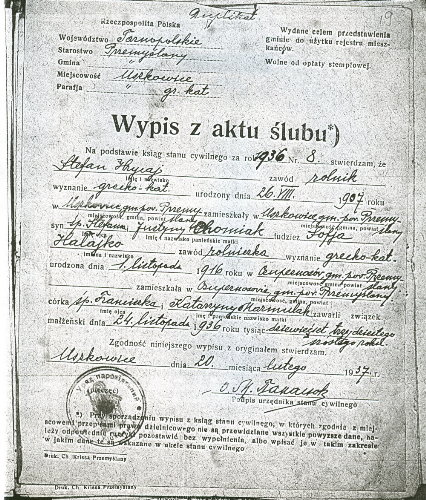 |
Duplicate
Republic of Poland
Issued for the purpose of showing to the sub-district
(gmina)
Province: Tarnopol
for the use of registering residents.
Jurisdiction: Przemyślany
Free of charge
Sub-district: Przemyślany
Place: Uszkowice
Parish: Uszkowice Greek Catholic
Extract of a
marriage
record
On the basis of the civil registry
for the year 1936, No. 8, I
affirm that
Stefan Hrycaj, occupation farmer,
religion Greek Catholic, born on 26th-VIII
1907 year
in Uszkowice, sub-district (gmina) &
district of Przemyślany, resided in
Uszkowice, sub-district (gmina) &
district of Przemyślany
son of the late (s.p.="sacred
memory") Stefan <Hrycaj> and
Justyna <maiden name> Chomiak also
Zofia
Hałajko, occupation
farmer, religion Greek Catholic,
born on 1 November 1916 year in
Czupernosów, sub-district (gmina) & district of
Przemyślany
resided in Czupernosów,
sub-district (gmina) & district of
Przemyślany
daughter of the late
(s.p.="sacred memory") Franciszek and Katarzyna
<maiden name> Marmulak
contracted a marital union on 24-November 1936 one thousand
nine hundred thirty six.
I confirm the agreement of this extract with the original.
Uszkowice day 20th
, month February
1937.
Signature of civil registrar
|
Extract of Death Record
inter-war period
Form written in Polish since at the time the
region was a part of the Poland. Often the information filled in is in
Polish, Latin (most likely copied directly from the original church record in
Latin) or Ukrainian and/or Ukrainianized Polish.
Note how quickly the form was filled out.
Abbreviations are used for the name of the province and district. "Trnol"
for Tarnopol (in Ukrainian Тернопіль/Ternopil) and
"Pryemysly" for Przemyślany (in Ukrainian
Перемишляни/Peremyshliany). Also, in each
case the first names are written in Latin, as in "Michael", "Joannes", "Anna").
Also, where the form asked for date of birth, the author of the document simply
wrote "70 years", most likely copied write from the original church register.
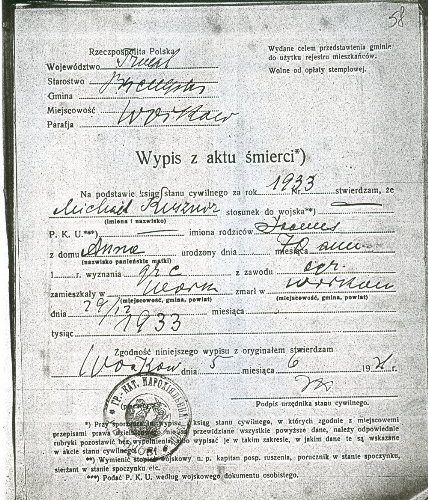 |
Republic of Poland
Issued for the purpose of showing to the sub-district
Province: Tarnopol (abbr.)
for the use of registering residents.
Jurisdiction: Przemyślany (abbr.)
Free of charge
Sub-district: Przemyślany
Place: Wołków
(abbr.)
Parish: Wołków
Extract of a birth
record
On the basis of the
civil registries for the year 1933
I affirm, that
Michael (Mykhailo in
Ukrainian) Kuszniz, military status**:
------
P.K.U.***: ---------, names of parents:
Joannes (in Latin, Ivan in Ukrainian)
of the maiden name Anna born on the day: _____
month: 70 years old
of the religious rite Greek Catholic, occupation: "agr"
(abbreviation for "agricola", Latin for farmer)
lived in Wołków, died in
Wołków
on 19th/12 (December)/1933.
I confirm the agreement of this extract with the original.
Wołków day 5 ,
month 6th (June)
1937 year.
Signature of civil registrar
|
Soviet-era Death Record
When the Soviet Union took over the region
of Eastern Galicia/Western Ukraine in 1939, they applied standard Soviet vital
record practices. Records were taken out of the churches and put in local
town record offices. This particular record comes from one of these
offices for the village of Usznia/Ushnia, located today in
Złoczów/Zolochiv district, in Lwów/Lviv province,
in Ukraine.
The form is written in Ukrainian and
Russian. However, all of the parts filled in by the author of the document
are in Ukrainian, including the signature. (there's a "soft sign" <ь>
after the "s" in Boiakovskii, which is characteristic of Ukrainian, not Russian)
The name of the local town record offices,
and associated abbreviations, changed over the course of time to reflect
national language and boundaries. The English is translated as
"Registration of Civil Records".
| Soviet-era Russian |
Зaпись aктов грaждaнского состояния (Zapis'
aktov grazhdanskogo sostoiania) |
ЗАГС |
| Soviet-era Ukrainian |
Запис актів громадянського стану (Zapys
aktiv hromandians'koho stanu) |
ЗАГС |
| Independent Ukraine Ukrainian |
Реєстрація актів громадянського стану |
РАГС |
| |
Реєстрація актів цивільного стану |
РАЦС |
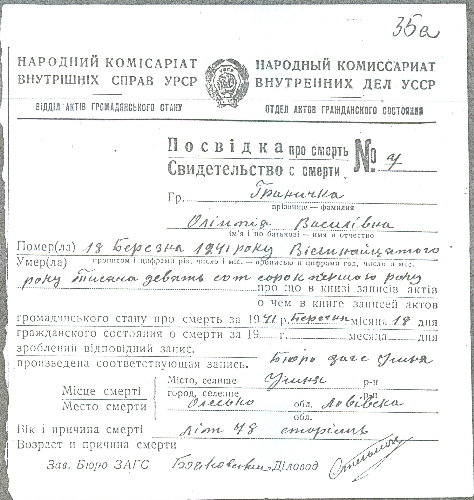 |
<Ukrainian>
<Russian>
Peoples Commissariat
People's Commissariat
of Internal Affairs
of Internal Affairs
Department of Civil Registration Records
Department of Civil Registration Records
<Ukrainian> Certificate of Death
Number 7
<Russian>
Certificate of Death
Citizen: Hranychka
Surname <in Ukrainian - in Russian>
Olimpia Vasylivna
Name and patrynymic <in Ukrainian - in Russian>
<Russian> Died: <written in
Ukrainian> 18 March 1941 year eighteenth
<Ukrainian> Died: (writing out
dates of year, day, and month) <in Ukrainian> <in Russian>
of the year one thousand nine hundred forty-one.
according to what is in the book of records
of civil registration of deaths for 1941 year March
month 18 day
made in accordance with the registration.
Bureau of ZAHS <village of> Ushnia
<in Ukrainian>
Place of death: town, village: Ushnia
district
<in Russian>
Place of death: town, village:
<in Russian>
district: Olesko
province: Lviv
<in Ukrainian>
district:
province:
<in Ukrainian>
Age and cause of death: 78 years, <старість>
old age
<in Russian> Age and cause of
death:
Head of the bureau of ZAHS
<signature> Boiakovskyi
|
|
